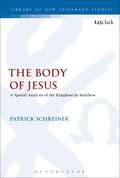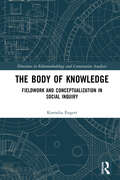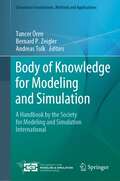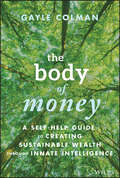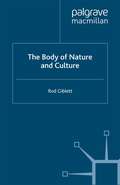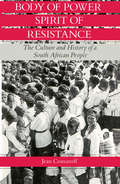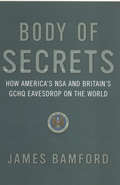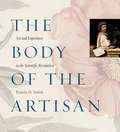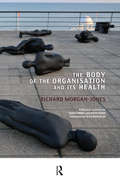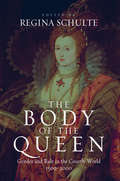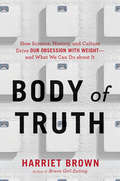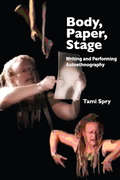- Table View
- List View
The Body of Jesus: A Spatial Analysis of the Kingdom in Matthew (The Library of New Testament Studies #555)
by Patrick SchreinerLittle attention is usually given to the space or place of the kingdom. Yet Matthew employs the distinctive phrase "kingdom of heaven†? and also portrays Jesus as Immanuel (God with us). In this volume Patrick Schreiner argues that by expanding one's view of space one can see that Jesus' purpose is to reorder the space of the earth in Matthew as the heavenly king. Jesus pierces the barrier between the two realms in his incarnation, and the spaces of heaven and earth begin to collide in his ministry. Therefore, in Matthew, Jesus does not just promise a temporal or ethereal kingdom, but one that is located, one that has a sense of rootedness. Jesus is granted authority over this space and inspires people to follow him in this construction project. The spatial kingdom begins in his body, and he extends it to his church by promising his presence.
The Body of Jesus: A Spatial Analysis of the Kingdom in Matthew (The Library of New Testament Studies)
by Patrick SchreinerLittle attention is usually given to the space or place of the kingdom. Yet Matthew employs the distinctive phrase “kingdom of heaven” and also portrays Jesus as Immanuel (God with us). In this volume Patrick Schreiner argues that by expanding one's view of space one can see that Jesus' purpose is to reorder the space of the earth in Matthew as the heavenly king. Jesus pierces the barrier between the two realms in his incarnation, and the spaces of heaven and earth begin to collide in his ministry. Therefore, in Matthew, Jesus does not just promise a temporal or ethereal kingdom, but one that is located, one that has a sense of rootedness. Jesus is granted authority over this space and inspires people to follow him in this construction project. The spatial kingdom begins in his body, and he extends it to his church by promising his presence.
The Body of Knowledge: Fieldwork and Conceptualization in Social Inquiry (Directions in Ethnomethodology and Conversation Analysis)
by Kornelia EngertThis book presents a vivid and close-up view of social science researchers engaged in fieldwork, in discussions with colleagues, and in writing. Adopting an ethnographic approach inspired by ethnomethodology and conversation analysis, the author pursues a praxeological analysis of social inquiry in situ. By conceiving of analytical practices such as observation, shop talk, and conceptualization in experiential terms, the seen but unnoticed structures of knowledge work are exposed and made available for empirical analysis. In a departure from ethnographic studies of research that focus on the physical sciences, the author uses the example of sociological research to shed new light on the role of self and mind for epistemic cultures, on the elusive materiality of conceptual objects, and on researchers’ experiential ways of seizing, reviewing, and accrediting knowledge. A rich and pervasive study of elementary sites in the research process, The Body of Knowledge will appeal to scholars of sociology, anthropology, and the humanities with interests in the epistemic practice of their own discipline, as well as those working in fields such as the social study of science, ethnomethodology and conversation analysis, and the sociology of interaction.
The Body of Knowledge: Fieldwork and Conceptualization in Social Inquiry (Directions in Ethnomethodology and Conversation Analysis)
by Kornelia EngertThis book presents a vivid and close-up view of social science researchers engaged in fieldwork, in discussions with colleagues, and in writing. Adopting an ethnographic approach inspired by ethnomethodology and conversation analysis, the author pursues a praxeological analysis of social inquiry in situ. By conceiving of analytical practices such as observation, shop talk, and conceptualization in experiential terms, the seen but unnoticed structures of knowledge work are exposed and made available for empirical analysis. In a departure from ethnographic studies of research that focus on the physical sciences, the author uses the example of sociological research to shed new light on the role of self and mind for epistemic cultures, on the elusive materiality of conceptual objects, and on researchers’ experiential ways of seizing, reviewing, and accrediting knowledge. A rich and pervasive study of elementary sites in the research process, The Body of Knowledge will appeal to scholars of sociology, anthropology, and the humanities with interests in the epistemic practice of their own discipline, as well as those working in fields such as the social study of science, ethnomethodology and conversation analysis, and the sociology of interaction.
Body of Knowledge for Modeling and Simulation: A Handbook by the Society for Modeling and Simulation International (Simulation Foundations, Methods and Applications)
by Tuncer Ören Bernard P. Zeigler Andreas TolkCommissioned by the Society for Modeling and Simulation International (SCS), this needed, useful new ‘Body of Knowledge’ (BoK) collects and organizes the common understanding of a wide collection of professionals and professional associations.Modeling and simulation (M&S) is a ubiquitous discipline that lays the computational foundation for real and virtual experimentation, clearly stating boundaries—and interactions—of systems, data, and representations. The field is well known, too, for its training support via simulations and simulators. Indeed, with computers increasingly influencing the activities of today’s world, M&S is the third pillar of scientific understanding, taking its place along with theory building and empirical observation.This valuable new handbook provides intellectual support for all disciplines in analysis, design and optimization. It contributes increasingly to the growing number of computational disciplines, addressing the broad variety of contributing as well as supported disciplines and application domains. Further, each of its sections provide numerous references for further information. Highly comprehensive, the BoK represents many viewpoints and facets, captured under such topics as:Mathematical and Systems Theory FoundationsSimulation Formalisms and ParadigmsSynergies with Systems Engineering and Artificial IntelligenceMultidisciplinary ChallengesEthics and PhilosophyHistorical PerspectivesExamining theoretical as well as practical challenges, this unique volume addresses the many facets of M&S for scholars, students, and practitioners. As such, it affords readers from all science, engineering, and arts disciplines a comprehensive and concise representation of concepts, terms, and activities needed to explain the M&S discipline.Tuncer Ören is Professor Emeritus at the University of Ottawa. Bernard Zeigler is Professor Emeritus at the University of Arizona. Andreas Tolk is Chief Scientist at The MITRE Corporation. All three editors are long-time members and Fellows of the Society for Modeling and Simulation International. Under the leadership of three SCS Fellows, Dr. Ören, University of Ottawa, Dr. Zeigler, The University of Arizona, and Dr. Tolk, The MITRE Corporation, more than 50 international scholars from 15 countries provided insights and experience to compile this initial M&S Body of Knowledge.
The Body of Money: A Self-Help Guide to Creating Sustainable Wealth through Innate Intelligence
by Gayle ColmanIn a world gone mad with money The Body of Money: A Self-Help Guide to Create Sustainable Wealth through Innate Intelligence is a comprehensive guide to building and sustaining wealth by using the incredible intelligence of the human body. The story you’ve been told about money is all wrong. Spreadsheets, PNL’s, money markets, and index funds only touch the surface. The Body of Money provides a completely unique and effective approach to personal finance like nothing you’ve experienced before. By demystifying money psychology and behavior economics Certified Financial Planner® and Master Integral Coach™ Gayle Colman shows you exactly how to use your innate wisdom to heal old money patterns, tend to wounds created by generational financial trauma and create sustainable wealth that is aligned with your deepest values. Integrating cutting-edge research, laugh-out-loud storytelling and body-centered practices, Gayle puts the power of individual wealth–building squarely back in your own hands. You will learn: How body practices can have a transformative effect on your money habits. Where your personal money manager lives in your body and how to access its true wisdom. Why investing in a way that matches your personal values can actually be better for your health. How to use your body to gain true financial agency, reduce debt, invest in real estate and make the most important money decisions of your life. The Body of Money is an indispensable approach to personal finance, perfect for any person seeking relief from money struggles and all individuals and families who want to create a robust and healthy money legacy for their lives.
The Body of Money: A Self-Help Guide to Creating Sustainable Wealth through Innate Intelligence
by Gayle ColmanIn a world gone mad with money The Body of Money: A Self-Help Guide to Create Sustainable Wealth through Innate Intelligence is a comprehensive guide to building and sustaining wealth by using the incredible intelligence of the human body. The story you’ve been told about money is all wrong. Spreadsheets, PNL’s, money markets, and index funds only touch the surface. The Body of Money provides a completely unique and effective approach to personal finance like nothing you’ve experienced before. By demystifying money psychology and behavior economics Certified Financial Planner® and Master Integral Coach™ Gayle Colman shows you exactly how to use your innate wisdom to heal old money patterns, tend to wounds created by generational financial trauma and create sustainable wealth that is aligned with your deepest values. Integrating cutting-edge research, laugh-out-loud storytelling and body-centered practices, Gayle puts the power of individual wealth–building squarely back in your own hands. You will learn: How body practices can have a transformative effect on your money habits. Where your personal money manager lives in your body and how to access its true wisdom. Why investing in a way that matches your personal values can actually be better for your health. How to use your body to gain true financial agency, reduce debt, invest in real estate and make the most important money decisions of your life. The Body of Money is an indispensable approach to personal finance, perfect for any person seeking relief from money struggles and all individuals and families who want to create a robust and healthy money legacy for their lives.
The Body of Nature and Culture
by R. GiblettThis book explores the relationship of human bodies with natural and cultural environments, arguing that these categories are linked and intertwined. It argues for an environmentally sustainable and healthy relationship between the body and the earth.
Body of Power, Spirit of Resistance: The Culture and History of a South African People
by Jean ComaroffIn this sophisticated study of power and resistance, Jean Comaroff analyzes the changing predicament of the Barolong boo Ratshidi, a people on the margins of the South African state. Like others on the fringes of the modern world system, the Tshidi struggle to construct a viable order of signs and practices through which they act upon the forces that engulf them. Their dissenting Churches of Zion have provided an effective medium for reconstructing a sense of history and identity, one that protests the terms of colonial and post-colonial society and culture.
Body of Power, Spirit of Resistance: The Culture and History of a South African People
by Jean ComaroffIn this sophisticated study of power and resistance, Jean Comaroff analyzes the changing predicament of the Barolong boo Ratshidi, a people on the margins of the South African state. Like others on the fringes of the modern world system, the Tshidi struggle to construct a viable order of signs and practices through which they act upon the forces that engulf them. Their dissenting Churches of Zion have provided an effective medium for reconstructing a sense of history and identity, one that protests the terms of colonial and post-colonial society and culture.
Body of Power, Spirit of Resistance: The Culture and History of a South African People
by Jean ComaroffIn this sophisticated study of power and resistance, Jean Comaroff analyzes the changing predicament of the Barolong boo Ratshidi, a people on the margins of the South African state. Like others on the fringes of the modern world system, the Tshidi struggle to construct a viable order of signs and practices through which they act upon the forces that engulf them. Their dissenting Churches of Zion have provided an effective medium for reconstructing a sense of history and identity, one that protests the terms of colonial and post-colonial society and culture.
Body of Power, Spirit of Resistance: The Culture and History of a South African People
by Jean ComaroffIn this sophisticated study of power and resistance, Jean Comaroff analyzes the changing predicament of the Barolong boo Ratshidi, a people on the margins of the South African state. Like others on the fringes of the modern world system, the Tshidi struggle to construct a viable order of signs and practices through which they act upon the forces that engulf them. Their dissenting Churches of Zion have provided an effective medium for reconstructing a sense of history and identity, one that protests the terms of colonial and post-colonial society and culture.
Body Of Secrets: Anatomy Of The Ultra-secret National Security Agency
by James BamfordThe NSA is the largest, most secretive and most powerful intelligence agency in the world. With a staff of 38,000 people, it dwarfs the CIA in budget, manpower and influence. Recent headlines have linked it to economic espionage throughout Europe and to the ongoing hunt for the terrorist leader Osama bin Laden. James Bamford first penetrated the wall of silence surrounding the NSA in 1982, with the much-talked-about US bestseller THE PUZZLE PALACE. In BODY OF SECRETS he offers shocking new details about the inner workings of the agency, gathered through unique access to thousands of internal documents and interviews with current and former officials. Unveiling extremely sensitive information for the first time, Bamford exposes the role the NSA played in numerous Soviet bloc Cold War conflicts and discusses its undercover involvement in the Vietnam War. His investigation into the NSA's technological advances during the last 15 years brings to light a network of global surveillance ranging from on-line listening posts to sophisticated intelligence-gathering satellites. In a hard-hitting conclusion, he warns the NSA is a double-edged sword: while its worldwide eavesdropping activities offer the potential for tracking down terrorists and uncovering nuclear weapons deals, it also has the capacity to listen in on global personal communications.
The Body of the Artisan: Art and Experience in the Scientific Revolution
by Pamela H. SmithSince the time of Aristotle, the making of knowledge and the making of objects have generally been considered separate enterprises. Yet during the late sixteenth and early seventeenth centuries, the two became linked through a "new" philosophy known as science. In The Body of the Artisan, Pamela H. Smith demonstrates how much early modern science owed to an unlikely source-artists and artisans. From goldsmiths to locksmiths and from carpenters to painters, artists and artisans were much sought after by the new scientists for their intimate, hands-on knowledge of natural materials and the ability to manipulate them. Drawing on a fascinating array of new evidence from northern Europe including artisans' objects and their writings, Smith shows how artisans saw all knowledge as rooted in matter and nature. With nearly two hundred images, The Body of the Artisan provides astonishingly vivid examples of this Renaissance synergy among art, craft, and science, and recovers a forgotten episode of the Scientific Revolution-an episode that forever altered the way we see the natural world.
The Body of the Artisan: Art and Experience in the Scientific Revolution
by Pamela H. SmithSince the time of Aristotle, the making of knowledge and the making of objects have generally been considered separate enterprises. Yet during the late sixteenth and early seventeenth centuries, the two became linked through a "new" philosophy known as science. In The Body of the Artisan, Pamela H. Smith demonstrates how much early modern science owed to an unlikely source-artists and artisans. From goldsmiths to locksmiths and from carpenters to painters, artists and artisans were much sought after by the new scientists for their intimate, hands-on knowledge of natural materials and the ability to manipulate them. Drawing on a fascinating array of new evidence from northern Europe including artisans' objects and their writings, Smith shows how artisans saw all knowledge as rooted in matter and nature. With nearly two hundred images, The Body of the Artisan provides astonishingly vivid examples of this Renaissance synergy among art, craft, and science, and recovers a forgotten episode of the Scientific Revolution-an episode that forever altered the way we see the natural world.
The Body of the Artisan: Art and Experience in the Scientific Revolution
by Pamela H. SmithSince the time of Aristotle, the making of knowledge and the making of objects have generally been considered separate enterprises. Yet during the late sixteenth and early seventeenth centuries, the two became linked through a "new" philosophy known as science. In The Body of the Artisan, Pamela H. Smith demonstrates how much early modern science owed to an unlikely source-artists and artisans. From goldsmiths to locksmiths and from carpenters to painters, artists and artisans were much sought after by the new scientists for their intimate, hands-on knowledge of natural materials and the ability to manipulate them. Drawing on a fascinating array of new evidence from northern Europe including artisans' objects and their writings, Smith shows how artisans saw all knowledge as rooted in matter and nature. With nearly two hundred images, The Body of the Artisan provides astonishingly vivid examples of this Renaissance synergy among art, craft, and science, and recovers a forgotten episode of the Scientific Revolution-an episode that forever altered the way we see the natural world.
The Body of the Artisan: Art and Experience in the Scientific Revolution
by Pamela H. SmithSince the time of Aristotle, the making of knowledge and the making of objects have generally been considered separate enterprises. Yet during the late sixteenth and early seventeenth centuries, the two became linked through a "new" philosophy known as science. In The Body of the Artisan, Pamela H. Smith demonstrates how much early modern science owed to an unlikely source-artists and artisans. From goldsmiths to locksmiths and from carpenters to painters, artists and artisans were much sought after by the new scientists for their intimate, hands-on knowledge of natural materials and the ability to manipulate them. Drawing on a fascinating array of new evidence from northern Europe including artisans' objects and their writings, Smith shows how artisans saw all knowledge as rooted in matter and nature. With nearly two hundred images, The Body of the Artisan provides astonishingly vivid examples of this Renaissance synergy among art, craft, and science, and recovers a forgotten episode of the Scientific Revolution-an episode that forever altered the way we see the natural world.
The Body of the Artisan: Art and Experience in the Scientific Revolution
by Pamela H. SmithSince the time of Aristotle, the making of knowledge and the making of objects have generally been considered separate enterprises. Yet during the late sixteenth and early seventeenth centuries, the two became linked through a "new" philosophy known as science. In The Body of the Artisan, Pamela H. Smith demonstrates how much early modern science owed to an unlikely source-artists and artisans. From goldsmiths to locksmiths and from carpenters to painters, artists and artisans were much sought after by the new scientists for their intimate, hands-on knowledge of natural materials and the ability to manipulate them. Drawing on a fascinating array of new evidence from northern Europe including artisans' objects and their writings, Smith shows how artisans saw all knowledge as rooted in matter and nature. With nearly two hundred images, The Body of the Artisan provides astonishingly vivid examples of this Renaissance synergy among art, craft, and science, and recovers a forgotten episode of the Scientific Revolution-an episode that forever altered the way we see the natural world.
The Body of the Artisan: Art and Experience in the Scientific Revolution
by Pamela H. SmithSince the time of Aristotle, the making of knowledge and the making of objects have generally been considered separate enterprises. Yet during the late sixteenth and early seventeenth centuries, the two became linked through a "new" philosophy known as science. In The Body of the Artisan, Pamela H. Smith demonstrates how much early modern science owed to an unlikely source-artists and artisans. From goldsmiths to locksmiths and from carpenters to painters, artists and artisans were much sought after by the new scientists for their intimate, hands-on knowledge of natural materials and the ability to manipulate them. Drawing on a fascinating array of new evidence from northern Europe including artisans' objects and their writings, Smith shows how artisans saw all knowledge as rooted in matter and nature. With nearly two hundred images, The Body of the Artisan provides astonishingly vivid examples of this Renaissance synergy among art, craft, and science, and recovers a forgotten episode of the Scientific Revolution-an episode that forever altered the way we see the natural world.
The Body of the Organisation and its Health
by Richard Morgan-JonesUsing the frameworks of psychoanalysis, group relations, systemic organisational observation, consulting and research, this book explores the relationship between the health of the work force and the health of organisations. It seeks to do this through an exploration of experience that has three dimensions linked in a single matrix: The bodily, the emotional and the social. This exploration is inspired by Bion's original idea of the protomental matrix from which the group dynamics of basic assumption mentality are derived, leading to his initial ideas about group diseases and their cures.
The Body of the Organisation and its Health
by Richard Morgan-JonesUsing the frameworks of psychoanalysis, group relations, systemic organisational observation, consulting and research, this book explores the relationship between the health of the work force and the health of organisations. It seeks to do this through an exploration of experience that has three dimensions linked in a single matrix: The bodily, the emotional and the social. This exploration is inspired by Bion's original idea of the protomental matrix from which the group dynamics of basic assumption mentality are derived, leading to his initial ideas about group diseases and their cures.
The Body of the Queen: Gender and Rule in the Courtly World, 1500-2000
by Regina SchulteHow many “bodies” does a queen have? What is the significance of multiple “bodies”? How has the gendered body been constructed and perceived within the context of the European courts during the course of the past five centuries? These are some of the questions addressed in this anthology, a contribution to the ongoing debate provoked by Ernst H. Kantorowicz in his seminal work from 1957, The King’s Two Bodies. On the basis of both textual self-presentations and visual representations a gradual transformation of the queen appears: A sacred/providential figure in medieval and early modern period, an ideal bourgeois wife during the late-18th and 19th Centuries, and a star-like (re-) presentation of royalty during the past century. Twentieth-century mass media has produced the celebrity and film star queens personified by the contested and enigmatic Nefertiti of ancient Egypt, the mysterious Elizabeth (Sisi) of Austria, Grace Kelly as Queen of both Hollywood and Monaco and Romy Schneider as the invented Empress.
Body of Truth: How Science, History, and Culture Drive Our Obsession with Weight--and What We Can Do about It
by Harriet BrownOver the past twenty-five years, our quest for thinness has morphed into a relentless obsession with weight and body image. In our culture, "fat" has become a four-letter word. Or, as Lance Armstrong said to the wife of a former teammate, "I called you crazy. I called you a bitch. But I never called you fat." How did we get to this place where the worst insult you can hurl at someone is "fat"? Where women and girls (and increasingly men and boys) will diet, purge, overeat, undereat, and berate themselves and others, all in the name of being thin?As a science journalist, Harriet Brown has explored this collective longing and fixation from an objective perspective; as a mother, wife, and woman with "weight issues," she has struggled to understand it on a personal level. Now, in Body of Truth, Brown systematically unpacks what's been offered as "truth" about weight and health.Starting with the four biggest lies, Brown shows how research has been manipulated; how the medical profession is complicit in keeping us in the dark; how big pharma and big, empty promises equal big, big dollars; how much of what we know (or think we know) about health and weight is wrong. And how all of those affect all of us every day, whether we know it or not.The quest for health and wellness has never been more urgent, yet most of us continue to buy into fad diets and unattainable body ideals, unaware of the damage we're doing to ourselves. Through interviews, research, and her own experience, Brown not only gives us the real story on weight, health, and beauty, but also offers concrete suggestions for how each of us can sort through the lies and misconceptions and make peace with and for ourselves.
Body, Paper, Stage: Writing and Performing Autoethnography (Qualitative Inquiry and Social Justice)
by Tami SpryTami Spry provides a methodological introduction to the budding field of performative autoethnography. She intertwines three necessary elements comprising the process. First one must understand the body – navigating concepts of self, culture, language, class, race, gender, and physicality. The second task is to put that body on the page, assigning words for that body’s sociocultural experiences. Finally, this merger of body and paper is lifted up to the stage, crafting a persona as a method of personal inquiry. These three stages are simultaneous and interdependent, and only in cultivating all three does performance autoethnography begin to take shape. Replete with examples and exercises, this is an important introductory work for autoethnographers and performance artists alike.
Body, Paper, Stage: Writing and Performing Autoethnography (Qualitative Inquiry and Social Justice #2)
by Tami SpryTami Spry provides a methodological introduction to the budding field of performative autoethnography. She intertwines three necessary elements comprising the process. First one must understand the body – navigating concepts of self, culture, language, class, race, gender, and physicality. The second task is to put that body on the page, assigning words for that body’s sociocultural experiences. Finally, this merger of body and paper is lifted up to the stage, crafting a persona as a method of personal inquiry. These three stages are simultaneous and interdependent, and only in cultivating all three does performance autoethnography begin to take shape. Replete with examples and exercises, this is an important introductory work for autoethnographers and performance artists alike.
